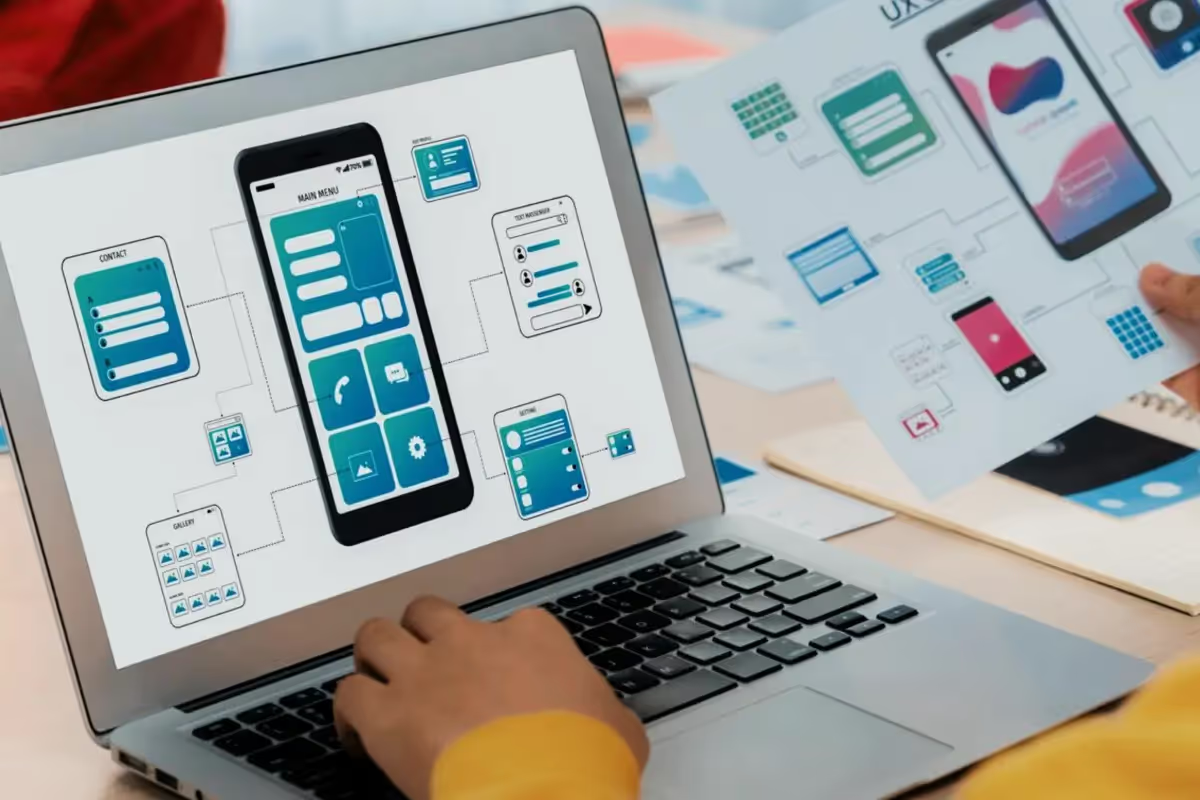Uber’s success story has driven many other startups to follow suit with a similar business model. It’s no surprise if you’re seeking information on how to start a company like Uber and replicate its revolutionary potential.
In 2019, the ride-hailing and taxi industry posted revenue of $302 billion worldwide. Despite the global pandemic crisis, the figure is expected to recover from its downturn and hit $365 billion in 2024.
There’s no better time to start an Uber-like business than the present. That’s when getting a product manager is helpful—or reading the tips shared by one. In this article, I’ll share my expertise in building Uber-like apps, give a detailed overview of Uber’s business model and MVP features.
At Uptech’s product department, we’ve helped many clients develop successful apps, so I believe we can nudge you in the right direction.
But first, let’s revisit the mercurial rise of Uber.
.png)
How Uber Got Started?
Uber was founded in 2009 by Garrett Camp and Travis Kalanick. Back then, it wasn’t the Uber that you’re familiar with today. It kicks off as a service for customers to hire black luxury cars in San Francisco.
In 2011, Uber revamped its idea and started connecting customers with regular cars. It revolutionized the taxi industry by providing convenience and a low-cost option for public transportation.
From a business point of view, it is a brilliant idea that answers the growing demand for an affordable ride and creates job opportunities for Uber drivers. Since then, Uber’s business model has been adopted in other industries with their respective on-demand delivery apps.
Interesting Taxi App Statistics
- Uber has 130 million monthly active users as of 2023;
- Uber generated $31.8 billion revenue in 2022, an 82% increase on the previous year;
- Uber owns 72% of the ride-hailing market share as of 2023;
- 131 million people use Uber or Uber Eats once a month, an 11% increase year-on-year.

How Does Uber Make Money?
So what is so special about Uber's business model that has fuelled a new startup, "on-demand economy"?
To put it simply, Uber works as a moderator between drivers and riders. It connects passengers who need a ride from point A to point B with drivers.
At first glance, it seems like Uber works like any other taxi company. But the backbone of Uber's business model is that the company doesn't employ drivers, which means it doesn't own the money generated through rides.
Uber makes money by collecting fees from the platform's gross bookings.
What does it mean?
When customers order a taxi through the Uber app, the app charges a 20-25% fee. The fee differs depending on the geographies and class of vehicles. What's more, it's not drivers who decide how much they'll charge for the ride. Uber follows standardized prices per kilometer/mile for different classes of rides/offerings. For example, in New York, a 7.5 km journey can cost from $25 to $280.
Cool, right?
Through its model, Uber moved from just being a taxi service to a really helping platform that takes people from A to B in the most affordable, dependable, and convenient way.
How Did Uber Get (Charm) Its First Customers?
Uber's business model was the first step forward to the disruption in the on-demand industry. The next stage was getting passengers and drivers on the platform in the most attractive way.
So the company came up with strong value propositions for both user roles. From my experience, it's a common case when the value proposition stage is underestimated, and startup owners jump into development right away.
My key point here is you need to think of user attraction first. This is what Uber did by offering passengers and drivers a range of benefits. So if you want to start a company as successful as Uber, create a solid value proposition. Here's what Uber offered to passengers and drivers.
Uber's Value Proposition for Passengers
- On-demand cab bookings;
- Real-time tracking;
- Accurate ETAs;
- Cashless rides;
- Lower wait time for a ride;
- Upfront pricing;
- Multiple ride options.
Uber's Value Propositions for Drivers
- Flexibility to drive on their own terms;
- Better income;
- Lower idle time to get new rides;
- Training sessions;
- Assistance in getting vehicle loans;
- Better trip allocation.
How to Start the Next Uber? An Easy Way
There’s no need to reinvent the wheel and go through the hassle of programming the platform from scratch. In fact, you can integrate an existing service into your mobile app and leverage their existing user base (and popularity).
What do I mean here? You can simply integrate Uber API into your app.
Here’s how to do it.
Step 1: Study the Uber API documentation
The first step is to have your development team study the Uber API documentation. Access to the Uber API is subject to approval by Uber, so it’s well worth making sure that developers are well-versed in its implementation before applying for access to the API.
Step 2: Get and implement SDK
Once approved, Uber will send an SDK (Software development Kit) to your development team, which they’ll have to study. Only then can they determine the best way to integrate the Uber API into your mobile app.
Step 3: Register for access to the Uber Developer Dashboard
The next step is for developers to register for access to the Uber Developer Dashboard. From here, developers can link your business app with the Google maps uber integration.
Step 4: Set up SDK for all app platforms
Developers proceed with setting up the Uber SDK to work with your mobile platform (iOS, Android, or both).
Step 5: Add all the functionality to the app
Developers will use the Uber SDK to add an Uber Ride Request button and other pertinent functions to the business app. Anything that people can use to submit an Uber service request through your mobile app.
Integrating the Uber API to your business app spares you the trouble of having to consult with a local taxi service. You don’t need to prepare documents or sign off on agreements that may not be beneficial to your business.
Uber developers have already prepared the infrastructure for you, along with access to a readily available taxi fleet and alternative modes of transport (bikes, scooters, etc.).
Of course, Uber is more than just a taxi-hailing platform but a complete logistics solution. Developers for Uber have also prepared an API that caters to the needs of businesses.
No matter how small (or big) your business is, you can gain peace of mind knowing that you can solve any logistics problem you might have with a few taps on your smartphone.
The successful integration of the Uber API to your business app hinges on your team of developers. Hence, it’s essential to make sure that you’re working with a team of developers who are well-versed in the process.
How To Build The Next Uber From Scratch
Well, if you decide you want to develop an Uber-like app from the very beginning, here’s your comprehensive guide.
First, you don’t actually need to build an exact app like Uber. Why? Cos Uber has been around for more than a decade, and in that span, many other ride-hailing apps are popping up in various countries.
Some are successful in their rights, but others withered away in a competitive industry. These 5 steps are crucial to start an Uber-like business.
Check out your competitors
You can gain a wealth of insights by researching your competitors. While the underlying technologies are similar, each of the competitors differs in terms of values and strategies.
Learning the strengths and weaknesses of the major players allows you to establish a unique value proposition. By doing that, you’ll avoid being just another Uber-wannabe in the market.
Capitalizing on the opportunity gap ensures that your ride-hailing app has a better chance for success.

Know your potential users
It’s always a mistake to create an app without getting feedback from the potential users. Are the users happy with the existing app, or is there a wishlist that will turn your app into the next Uber?
Assumptions will only lead to failure when the app does have the right product/market fit. Instead, you’ll want to conduct surveys individually or in a group to find out the pain points that are yet to be solved.
Besides, you may have a pool of ready-tester from the users that you’ve surveyed.
Choose your business model
Uber's business model I described above isn't cast in stone. You're free to adapt and change the original business model that works for you.
This is what BlaBlaCar did by offering ride-sharing services. Instead of paying for the service, customers pay directly to the driver for sharing the fuel and wear-and-tear expenses.
The critical thing here is to ensure that your business model guarantees a return on investment, efficiency, and flexibility.
.png)
Stay focused on user experience
Technical glitches, bad design, and transaction failure are inexcusable when building an Uber-like app. Users have zero tolerance for an app lacking in UI/UX, particularly if it means getting late to their destination.
Again, you can turn to your competitors to find out what’s working and what’s not. It also helps to create a mockup and test it out with a target group of users.
Test with an MVP (Or On Paper)
Forget fancy features like a loyalty program. What matters the most is getting the basic app to the market fast and improvising based on the feedback.
Prior to the launch, you’ll want to focus on the basic features critical for a ride-hailing app. Ensure that these features are functional, flawless, and user-friendly.
By testing with an MVP, you’ll have more accurate feedback as the users are not distracted by unnecessary features.
However, if you’re tight on budget, you can get pretty good results with a paper prototype. The key idea is to get feedback from the users as you chart the way forward.

Tech Stack for Uber-like app
To build a taxi app like Uber, you’ll need the right tools and technologies.
Uber is pretty transparent on their choice of tech stack, and here’s an article of it.
Uber’s engineers primarily write in:
- Python
- Node.js
- Go
- Java
We started with two main languages: Node.js for the Marketplace team, and Python for everyone else. These first languages still power most services running at Uber today.
They also use C and C++ for high-efficiency, high-speed code at the system level.
If you’re a non-tech startup, going through the list of tools and technologies will be overwhelming. It’s best to leave that to the IT professionals who are building the app for you.
Here’s the question.
Should you use the same tech stack that powers Uber’s platform?
I’ll say it depends. Uber’s app has evolved, along with its choice of tech stack. For example, Uber started with PostgreSQL before switching to Schemalesss to meet its tremendous growth rate.
An MVP can be built by almost any techstack, but if you’re planning for growth, you’ll want to choose a scalable tech stack from the start.
Doing so prevents rebuilding the app from scratch, which costs time and money.
How to Start the Next Uber: Main Features
Let’s see what features you need to include in your Uber-like app. Below, I gathered features for the user app, driver app, and admin panel.
Must-have features are just the beginning of any app. You need to add new functionality to become a full-fledged app and compete in the market. That’s why I also included nice-to-have features too.
Must-have Features
- Sign up/login - allows users to create an account and log in to the app.
- Integration with Maps - display locations on a digital map.
User app
- Track user/driver location - Display the location of the user and driver in real-time.
- Pick-up location - Provides the option to set the pickup location on the map or via text input.
- Destination location - Allow users to specify the destination on the map or through text input.
- In-app payment options - Support one type of popular payment methods.
- Become a driver - Provides a form for riders who are interested in registering as a driver.
Driver App
- Receive order - Allow drivers to view an order from a list.
- Accept order - Let drivers confirm an order.
- View route to the drop locations - Project the best route to the rider’s location.
- Check balance - Allow drivers to check their earnings.
Admin Panel
- List of orders - Records of all orders transacted over the apps.
- List of driver applications - Allow admins to view, accept, or reject driver applications.
- Manual Payouts - Allow the admin to execute payouts manually.
- Matching algorithm - Intelligently match nearby drivers that fit the rider’s search criteria.
Nice-to-have Features for Uber-like App
User app
- Pre-booking - allows users to book the ride in advance.
- Vehicle type - Let users choose the type of vehicle for the ride.
- Multiple drop-offs - Enable a sequence of locations in a single ride.
- Trip -history. - Users can check their past records on the app.
- In-app chat/call - Allow riders and drivers to communicate within the app.
- View driver reviews and ratings - Ratings and reviews are shown on the driver’s profile.
- Rate driver and leave review - Allows users to rate and review their drivers.
- Preferred driver - Users can save their favorite drivers on the app.
- Loyalty program/bonuses - Accumulate points which are exchangeable for gifts and rewards.
- View and edit profile - Birthday, and other useful information for targeted marketing in the future.
Driver App
- Reject order - With this, the driver can turn down orders.
- Rate user - Drivers can now rate their passengers.
Admin Panel
- Automatic payout - Payout is automatically done as configured.
- Analytics - Provide insights into driver performance, orders, revenue, rider demographic, and more.
What Affects the Cost of Making an App Like Uber?
There are a few things to think about when making your own app similar to Uber. When we start working with clients, we want to know their ideas about important things. Besides the basic app concept, budget, timeline, and needs, we also want to know their business goals to make sure we achieve them.
Now, let's see what things can change the price of building an app like Uber.
Features
The features you choose for your app decide how much it will cost. The price changes based on the simple and advanced features you want to include in the app.
For example, Uber and Lyft started with basic versions of their services and then added more features over time.
Type of Your Business
This is important too. Do you already have a taxi service or are you building a startup? If you already have a service, we can make the app to fit how your business works. But if you're starting new, you might need to work with a tighter budget.
App Platform
Choosing where your app will work matters. If you want lots of people to use it, pick both Android and iOS. If your budget is small, you might start with just one of them, based on who you want to use your app. Uber first launched on iOS because iPhones were really popular at that time.
Technology
Usually, it's better to make a native app instead of a mixed one. They are different in how they're built and the programming languages used.
If you're not experienced with technology, it's smart to talk to an expereinced mobile development companny, like Uptech before you decide completely on how to create your app similar to Uber.
What’s the Cost of Building an Uber-like app?
As we've discussed, the cost depends on how much time is spent on development. It's important to note that this section covers the time and expenses for building the MVP of an Uber-like app. The final cost of the app will vary based on the features you choose to include.
Now, let's break down the time and costs required to create an MVP for both drivers and customers in an Uber-like app.
Total development time of an MVP for iOS and Android will be around 100 hours.
If you have your dev team in USA, the cost will be around $10,000-12,000.
If you hire the dev team somewhere in Western Europe (UK, Germany), the price will be a bit lower, at around $90,000-11,000.
If you choose to work with Uptech, we offer services with the price tag at aroud $35-50 per hour. So you’ll cut the cost twice and need to invest in your Uber-like app $3,500-5,000.

Let’s move futher. To develop an MVP (for iOS and Android) of an app like Uber for drivers with all the functionality I mentioned in the features block, you need to devote ~ 650 hours.
Total development time of the user app is around 1000 hours.
With Uptech it will cost you from $22,750 to $32,500 for driver app. And $35,000 - $50,000 for user app.
Moreover, it's important to account for the creation of the admin panel, which is essential for managing the app. At an estimated rate of $50 per hour, the total cost for developing the admin panel is $14,000.
Taking it all into account, developing an Uber-like app will cost around $57,000 and $114,000 for one or two user apps (iOS and Android) respectively. Also, mind the price of admin panel development which may start at $14,000.
Note, this ballpark range may vary depending on the complexity of the design and list of features added to the scope. If you need a more precise estimate, contact our team.
Conclusion
Uber's success started a chain reaction with hundreds of on-demand startups. And the story of this company is truly remarkable. Starting from a value proposition to the business model they created – altogether worked as a booming mix.
The thing I wanted to highlight in this article was that you shouldn't copy Uber's story to start a company like Uber. On-demand transportation and logistics industries are full of uncovered needs. If you study the market well, find the niche and focus on customers' needs – you'll make it a win.






















































































.avif)













